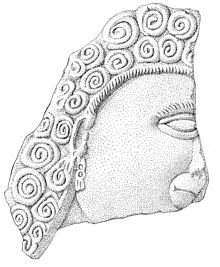Zafar (Himyars)

Zafar ( Old South Arabic ẓfr , Greek : Tapharon , Latin Sapphar , Arabic ظفار, DMG Ẓafār ) was the capital of the ancient South Arabian kingdom of the Himyars from 110 BC. The royal castle of Raydan was the center and seat of the rulers until the Aksumite conquest in 525 .
history
Under the rule of the Himyars, the whole of Arabia was united for the first time . The rulership comprised an area of around 2.5 million square kilometers, an order of magnitude that corresponds to three quarters of Western Europe. The ancient capital is located in the Yemeni highlands between Aden and Sana'a , with the site at an altitude of 2,800 meters, about 14 kilometers southeast of the provincial town of Yarīm . Zafar owes its original wealth to its location on the western edge of a fertile agricultural plain, the Qa al-Haql. Zafar's reasoning turns out to be obscure in an archaeological sense. Artifacts that were found in the area are kept in a local museum. Excavations on site led to the discovery of rich relief sculptures. Individual artifacts from the early Himyarian period, about 110 BC. BC to 270 AD, could be gleaned from the surface of the earth without excavation. However, many artifacts that have been excavated appear to be more recent and date from the Empire period from 270 to 525. An inscription written in ancient Ethiopian dates back to the days after the Aksumite conquest. Today's village of Zafar has only 400 people.
The main source of insight into history are Old South Arabic [musnad] texts from the 1st century BC. Pliny mentions the city in his Naturalis historia . The author of the Periplus Maris Erythraei is unknown ; a possibly experienced traveling salesman describes Zafar as a royal city. Both works date from the 1st century AD. The mathematician and geographer Claudius Ptolemy also briefly mentions Zafar in his Geographia, which dates from the 2nd century . Due to coordinate shifts, the Ptolemaic map was probably changed in the Middle Ages, when the metropolis Sapphar - according to today's knowledge incorrect - appears in today's eastern Oman.
Even early Christian authors mention Zafar, such as Philostorgius , learns from the one that in the fourth century the Himyaren a church was offered. Texts about the bishop Gregentios are rather dubious. Zafar was a center for polytheists, Jews and later for Christians. The city plays an important role as a site for the formative of monotheistic religions.
A large inscription documents a palace that existed around 457 AD. It mentions ambassadors with Ethiopian names. Perhaps in the course of an uprising, the city was destroyed around 539. The polymath al-Hamdānī described in the 10th century - in the eighth volume of his main work al-Iklīl - some ruined cities, including Zafar. Excavations uncovered tombs and a temple. There are also numerous reliefs with plant ornaments and human sculptures . Old South Arabic texts mentioned five palaces for the Himyar capital, Hargab , Kallanum , Kaukaban , Shawhatan and Raydan . Raydan is described as a state palace.
From 1998 to 2011 the archaeologist Paul Yule carried out excavations in Zafar on behalf of the University of Heidelberg . Geoinformatics methods were also used for site research.
The current housing stock in Zafar is made up of himyarian ruins. The houses were built regularly in the middle of the 20th century.
See also
literature
- Walter W. Müller : Zafār. In: Encyclopaedia of Islam. Vol. 11, fasc. 185-186. Leiden 2001, pp. 379-380. ISBN 90-04-07026-5
- Paul Yule : Himyar – Late Antique in Yemen / Late Antique Yemen. Linden Soft, Aichwald 2007. ISBN 3-929290-35-9
- Paul Yule, K. Franke, C. Meyer, G. Nebe, C. Robin, C. Witzel: Zafar, Capital of Himyar, Ibb Province, Yemen First Preliminary Report: 1998 and 2000, Second Preliminary Report: 2002, Third Preliminary Report : 2003, Fourth Preliminary Report: 2004. ABADY 11 (Mainz 2007 [2008]) 479-547, pls. 1–47 + CD-ROM, ISSN 0722-9844 , ISBN 978-3-8053-3777-9 - digital version
- Paul Yule: The Gates of Ḥimyarite Ẓafār. Chroniques yéménites 14, 2007, 1–13, ISSN 1248-0568 - digital version
- Paul Yule: Ẓafār, Capital of Ḥimyar, Fifth Preliminary Report, February – March 2005. Journal of Archeology of Non-European Cultures 2, 2007 [2008] 105–120, ISBN 978-3-89500-649-4 Digital version
- K. Franke / M. Rösch / C. Ruppert / P. Yule, Ẓafār, Capital of Ḥimyar, Sixth Preliminary Report, February – March 2006. Zeitschrift für Orient- Aräologie 1, 2008 [2009] 208–245, ISBN 978-3-11-019704-4 - digital version
- Armin Kirfel / Winfried Kockelmann / Paul Yule, Non-destructive Chemical Analysis of Old South Arabian Coins, 4th Century BCE - 3rd century, Archeometry vol. 53, 2011, online ISSN 1475-4754
- Paul Yule: Ẓafār, Capital of Ḥimyar, Rehabilitation of a 'Decadent' Society, Excavations of the Ruprecht-Karls-Universität Heidelberg 1998–2010 in the Highlands of the Yemen. Treatises of the German Orient Society, Harrassowitz, Wiesbaden 2013, ISBN 978-3-447-06935-9
Web links
- The Zafar virtual museum at Heidelberg University
- HeidICON image server
- Writings of Paul Yule on Arabia ( Memento of February 16, 2012 in the Internet Archive )
- Baynun
Individual evidence
- ↑ a b c d Paul Yule, Himyar – Spätantike im Yemen / Late Antique Yemen , p. 21 ff. (See lit.)
- ^ Philostorgios, 3.4
- ↑ W. Müller: Zafār , S. 379th
Coordinates: 14 ° 13 ' N , 44 ° 24' E


